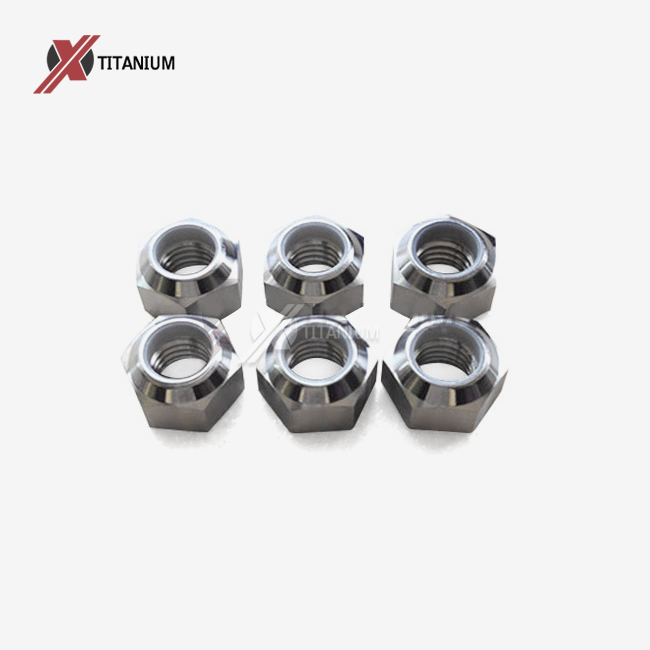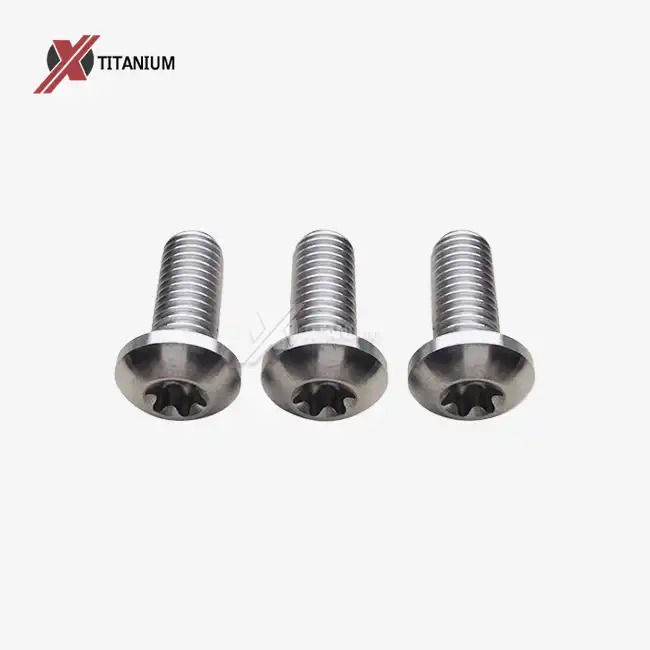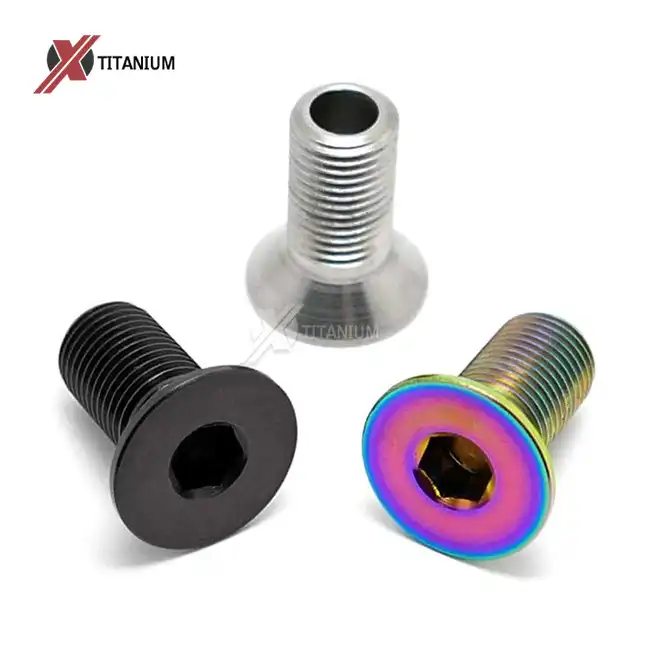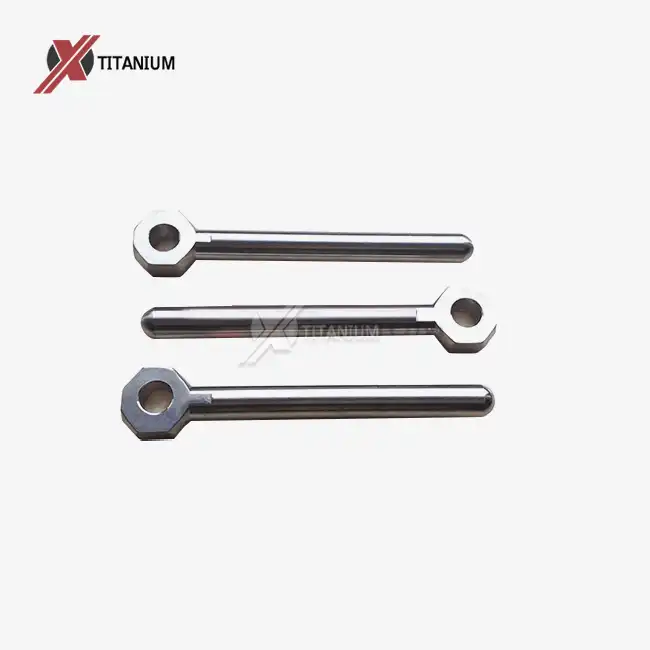Understanding Titanium Lock Nuts: Composition and Properties
The Unique Characteristics of Titanium
Titanium lock nuts are crafted from one of the most remarkable metals known to engineering. Titanium boasts an impressive strength-to-weight ratio, making it a preferred choice in industries where every gram matters. These nuts derive their exceptional properties from titanium's inherent characteristics, including corrosion resistance, high tensile strength, and the ability to withstand extreme temperatures.
The most common titanium alloy used for lock nuts is Grade 5 (Ti-6Al-4V), which contains 6% aluminum and 4% vanadium. This composition enhances the already impressive properties of pure titanium, resulting in fasteners that can withstand harsh environments and heavy loads while remaining lightweight.
Lock Nut Design and Functionality
Lock nuts are engineered to prevent loosening under vibration or dynamic loads. Titanium lock nuts typically employ one of several mechanisms to achieve this:
1. Nylon insert lock nuts: These feature a nylon ring that deforms slightly when threaded onto a bolt, creating friction.
2. All-metal lock nuts: These use various designs like deformed threads or split-ring configurations to generate locking force.
3. Prevailing torque lock nuts: These maintain consistent torque throughout their lifecycle, providing reliable locking performance.
The choice of locking mechanism can influence the reusability of titanium lock nuts. For instance, nylon insert lock nuts may lose some of their locking ability after multiple uses as the nylon deforms, while all-metal designs might maintain their performance longer.
Factors Affecting the Reusability of Titanium Lock Nuts
Installation and Removal Processes
The manner in which titanium lock nuts are installed and removed plays a significant role in their reusability. Proper torque application during installation is crucial; over-tightening can lead to thread damage or deformation of the nut, compromising its locking ability and reusability. Similarly, the removal process should be carried out with care to avoid damaging the nut or bolt threads.
Using appropriate tools and techniques is essential. For example, employing a torque wrench ensures consistent and accurate tightening, while avoiding the use of impact tools can prevent potential damage to the titanium components.
Environmental and Operational Conditions
The environment in which titanium lock nuts operate significantly impacts their lifespan and reusability. While titanium is renowned for its corrosion resistance, extreme conditions can still affect the nuts' performance over time. Factors to consider include:
1. Temperature fluctuations: Repeated heating and cooling cycles can cause material fatigue.
2. Chemical exposure: Although resistant to many chemicals, certain substances may degrade titanium over time.
3. Mechanical stress: High-vibration environments or frequent load changes can wear down locking mechanisms.
4. Galvanic corrosion: When in contact with certain other metals, titanium can experience accelerated corrosion.
Understanding these factors is crucial for assessing whether a titanium lock nut can be safely reused in its specific application.
Quality and Grade of Titanium Used
The quality and grade of titanium used in manufacturing lock nuts directly influence their durability and reusability. Higher-grade titanium alloys, such as Grade 5 (Ti-6Al-4V), offer superior strength and resistance to wear, potentially allowing for more reuse cycles compared to lower grades.
Additionally, the manufacturing process and quality control measures employed by the producer play a vital role. Precision-machined titanium lock nuts from reputable manufacturers are more likely to maintain their performance over multiple uses compared to lower-quality alternatives.
Best Practices for Reusing Titanium Lock Nuts
Inspection and Evaluation Techniques
Before reusing titanium lock nuts, a thorough inspection is paramount. This process should include:
1. Visual examination: Look for signs of wear, deformation, or damage to threads and locking mechanisms.
2. Dimensional checks: Ensure the nut still meets specified tolerances using precision measuring tools.
3. Functional testing: Verify that the locking mechanism still provides adequate resistance.
4. Surface analysis: Check for any signs of corrosion, pitting, or material degradation.
Advanced inspection techniques such as ultrasonic testing or X-ray analysis may be necessary for critical applications to detect any internal flaws or fatigue.
Maintenance and Cleaning Procedures
Proper maintenance can extend the usable life of titanium lock nuts. After removal and before reuse, consider the following steps:
1. Cleaning: Remove any debris or contaminants using appropriate solvents or ultrasonic cleaning methods.
2. Lubrication: Apply a thin layer of suitable lubricant to reduce friction and prevent galling during reinstallation.
3. Thread restoration: If minor thread damage is present, carefully clean and restore the threads using appropriate tools.
4. Storage: Keep cleaned nuts in a dry, contaminant-free environment to prevent degradation between uses.
It's important to note that some specialized coatings or treatments applied to titanium lock nuts may be affected by cleaning processes, so consult manufacturer guidelines when available.
Guidelines for Safe Reuse
While titanium lock nuts can often be reused, it's crucial to follow these guidelines to ensure safety and reliability:
1. Adhere to industry standards and regulations regarding fastener reuse in your specific application.
2. Maintain detailed records of each nut's usage history, including number of installations and operating conditions.
3. Consider the criticality of the application – in safety-critical systems, it may be prudent to use new nuts for each installation.
4. Consult with the manufacturer or a qualified engineer if there's any doubt about the suitability of reuse.
5. Implement a system for tracking and retiring nuts that have reached their maximum recommended reuse limit.
By following these best practices, you can maximize the value of titanium lock nuts while maintaining the integrity and safety of your assemblies.
Conclusion
Titanium lock nuts offer exceptional performance in demanding applications, and their potential for reuse adds to their value proposition. However, the decision to reuse these fasteners should be made carefully, considering factors such as installation methods, operating conditions, and the quality of the nuts themselves. By implementing rigorous inspection, maintenance, and evaluation processes, engineers and technicians can safely extend the life of titanium lock nuts in many applications.
For those seeking high-quality titanium fasteners, including reusable lock nuts, Baoji Chuanglian New Metal Material Co., Ltd. offers a wide range of titanium products tailored to various industrial needs. With over a decade of experience in titanium manufacturing and research, we provide reliable solutions for aerospace, medical, racing, and many other demanding fields. To learn more about our titanium lock nuts and other products, please contact us at info@cltifastener.com or djy6580@aliyun.com.




